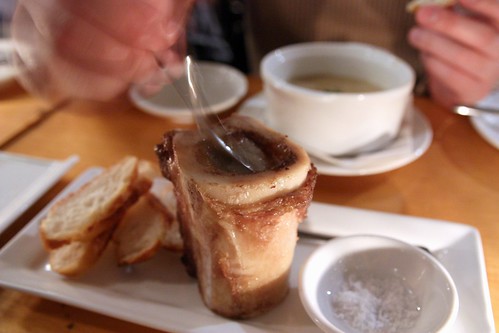Full Milk Moon
**** **** **** **** **** **** ****
It is the full moon (er.. a little past) of the month that Annette Hinshaw calls the Milk Moon and Jessica Prentice calls the Hunger Moon. It is late in the winter and in milder climates spring may be hinting at it's arrival, but it is not yet here. There is an old saying in New England, though, "half the wood and half the hay you should have left on Candlemas day." In those northern places winter is only half over. Both Annette Hinshaw and Jessica Prentice write about how we can manage our resources during these hard times through our choices and our connections in order to nourishing what is growing in our lives.
In our post industrial, urban world many of us don't even notice that there is a seasonality to the abundance or lack of food. The farmers markets may not be open this time of year, and we may be missing tasty peaches and strawberries, but everything else is still available in our local mega mart. I visited a small produce market near my new school last week that focuses on local foods and found a vast abundance of good looking produce. As expected they had lovely apples from this autumn's harvest stacked in crates out front and piles of local hardy greens but they also had bell peppers, celery, fresh herbs and even a few hot house tomatoes. We never have to fast to conserve resources and when people in our country are hungry it is from lack of money, not the unavailability of food.
 |
| Menudo by scaredy_kat |
Traditional cultures knew the value of foods that stretch resources and can provide nourishing food even when the stores are low. Dried grains, root crops, fermented vegetables, hard cheeses and soups are the staple foods of most European cultures and the winter foods of Asia and North America are similar. The hearty soups that people across the globe eat during hard times to keep nourished and elevate into high cuisine in the good times are all based on one important food source - animal bones. Chinese egg drop soup, Korean gomguk, Thai tom yum, Norweigian cabbage soup, Russian shchi, Irish mutton stew, French onion soup, Mexican menudo and Cherokee pepper pot stew are all traditional soups that start with animal bones and end with a warm, nutritious meal perfect for late winter. In the Cherokee calendar, this month of the year is called the Bone Moon. I think that is fitting.
I make stock out of chicken, beef and whatever other bones make their way through my kitchen on a regular basis. I collect bones, both raw and cooked, along with vegetable scraps in a plastic zip bag in the freezer and make stock when I have about a gallon of scraps. The stock can simmer for a few hours, or a few days before you have to deal with it again, and the finished stock can stay in your fridge for a few days or your freezer for a few months. We use it to make soup, stew, polenta, rice and many other dishes that are infinetly more delicious and nutritious when made with home made stock. In fact, last weekend, my sister made a most delicious white bean and kale soup with homemade stock.
*** *** ***
Home Made Bone Stock
1/2 -1 gallon of assorted chicken, pork, beef or other bones (use mostly chicken, with some others... for beef stock see these instructions)
4-6 cups of assorted vegetable scraps from carrots, onions, garlic, celery, mushrooms or other non-cruciferous (cabbage family) vegetables
1 onion, cut in half with skin (if not enough onion in the veggie scraps)
2-4 cloves of garlic, smashed with skins (if not enough garlic in the veggie scraps)
2 tbs cider vinegar or 1/4 cup white wine1 tsp whole pepper corns
1-2 tsp salt
fresh or dried herbs including thyme, rosemary, sage or bay (optional)
Put the bones and veggies in a large stock pot (spaghetti pot or larger) and cover with cold water. Add the vinegar or wine and slowly bring the pot to a boil. If your bones are frozen, you can turn the heat to medium until everything is defrosted and warm, then up to high to boil. As it comes to a boil, skim any foam that rises to the top off and discard (don't skim too much fat off if you have it on top of the pot, that's good stuff!). Add the salt, peppercorns and optional herbs. Put a lid on the pot, turn the heat down to low or medium low to maintain a slow simmer.
 |
| Kale and White Bean Soup by little blue hen |
Chicken stock is ready to strain and use after 4-6 hours, but can also be cooked considerably longer. I often simmer for a few hours, put the lid on and turn the heat off, then bring back to a boil and simmer again the next day. I've never gotten sick, yet, but if you are worried, just strain and refridgerate your stock whenever you are done letting it simmer. I strain my stock through a colander with or without a wire sieve in it (depending on how lazy I am feeling - I don't mind a cloudy stock) and pour it into various sized plastic containers to go into the freezer.
White Bean and Kale Soup
2 quarts home made chicken stock, or a mix of stock and water
2 tbs olive oil, chicken fat or bacon fat
1 linguica sausage, chopped
1 onion, chopped fine
3 cloves of garlic, sliced, chopped or pressed
2 tsp red pepper flakes
1 tsp Italian seasoning
Salt and pepper to taste
1 can white beans, drained and rinsed or 2 cups homemade white beans
1 quart of kale, trimmed and chopped
1-3 tsp lemon juice or cider vinegar
In 4 quart soup pot, heat the oil and fry the linguica until it has rendered it's fat and is starting to brown. Add the onion, pepper flakes and Italian seasoning along with some salt and pepper. Fry until the onion is soft and golden and add the garlic, frying another minute or so until fragrant.
Add the chicken stock and bring to a boil. Lower the heat to a simmer and add the white beans and kale. Cook for at least 10 minutes or until the beans are hot and the kale is wilted and soft. Adjust the seasoning with salt, pepper and lemon juice. Serve with cheese toasts, croutons, sauer kraut or whatever garnishes you like on soup.
*** *** ***
Every Jewish grandmother knows that chicken soup will cure what ails you, from colds and flu to a broken heart or wrinkley face. Modern science is piling up more and more evidence that she is right. The connective tissue in bones and carcasses is full of gelatin and other nutrients that support healthy bones, joints, skin and hair. Gelatin is also a very nutritious and soothing protein that people of all ages and health levels can digest. Bone marrow, the fatty middle part of long bones, is an especially nutritious food that might support immune function but definitely supports a delicious meal. You can ask your butcher to cut long bones into
 |
| Silky Healthful Fat by Sifu Renka |
2-3 inch slices, roast the bones and then pull the marrow out and spread it on toast. The marrow course was the highlight of my sister and I's recent trip to a fancy restaurant in downtown Portland.
In addition to being good for the body, making stock is good for the soul and spirit, too. It is recycling at it's best and a truly respectful way to treat the animals we use for food. Bart Everson speaks eloquently of this transformation and what it means to him on the blog Humanistic Paganism. I know, too, that there is magic in taking the leftovers, the scraps and the ends and turning them, through long simmering, into a wonderful elixer of health and flavor. This can be a hard, hard time of the year especially if we are disconnected from our community and support. Using ancient and wise techniques like fasting, sharing or making bone soup reminds us that we do have the resources to nourish ourselves and each other, even when it looks like all we have is a picked over plate.
How do you nourish yourself and your community during this dark time of late winter? Do you make stock at your house or have any memories of a lovingly made soup? What other recipes do you like for turning leftovers and left-behinds into loving nourishment? Do you prefer tom yum or french onion soup?
**** **** **** **** **** **** ****
Full Milk Moon 2009: Nourishing Self As Well As Others
Full Milk Moon 2010: The Full Wolf Moon
Full Milk Moon 2011: The Positive Feedback Loop of Love
Check the recipes and soup tags for more posts with yummy food.
** This winter was tough and I got messed up in my calendar. I wrote this thinking it was the Fasting Moon but it was really the Milk Moon. Since the post itself is more about the the Bone Moon, I just changed the tags and labels. For more on my thoughts about this, see this post. **
1 comment:
Sweet posting. I'm glad to see another moon/food blogger out there! I just finished some excellent mallard duck stock just in time for the full bone moon!
fischer
Post a Comment